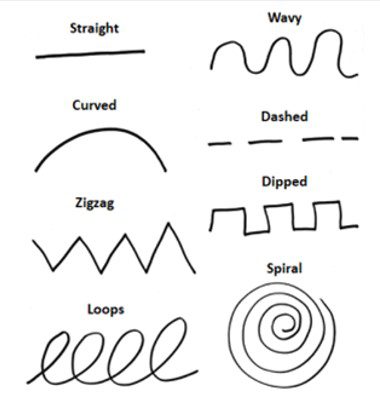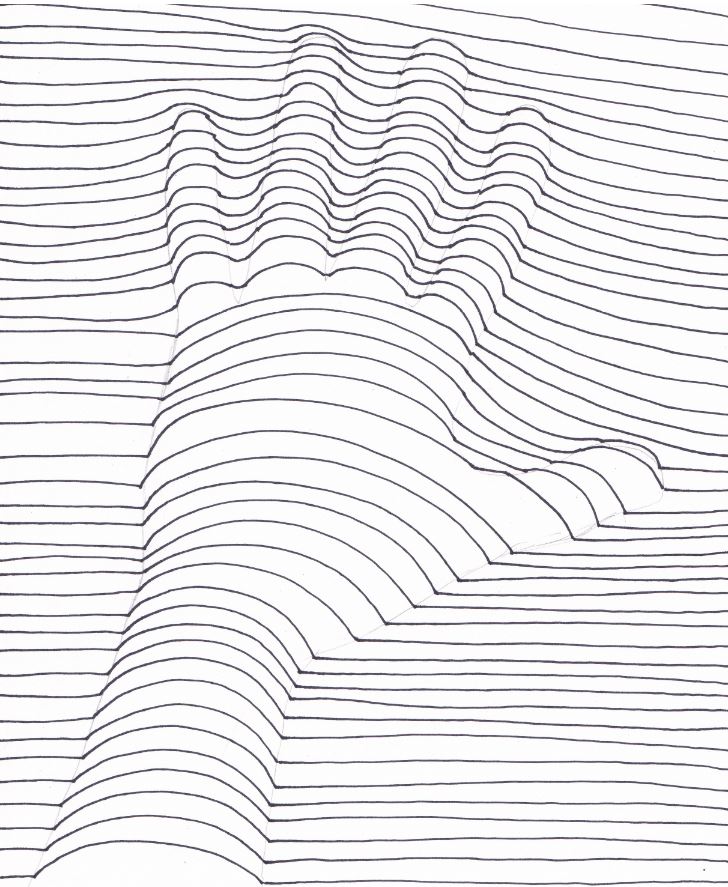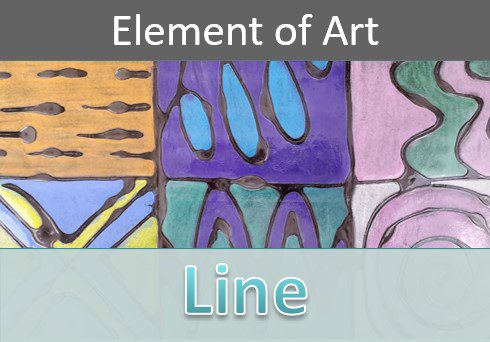Line, an Element of Art
Line is the most basic of the elements of art. Drawings can not be made without the use of line. Paintings require its use as well. In this lesson we’ll take a deep dive into the element of art line, and how to use it to create amazing works of art.
You’ll also see examples of how to use line to create art and we’ll show you activities and drawings you can do to improve your skills.
What is Line in Art, and How is it Used?
“A line is a dot that went for a walk” – Paul Klee. It’s considered to be the most basic of the elements of art. And it’s also said that no art can be created without the use of line.
There are many types and styles of line. As well as many ways to use line to create your artwork. We’ll explore all of these in this article.
Types of Line
Vertical lines go straight up and down without and bends or angles
Horizontal lines go straight across without and bends or angles
Diagonal lines go on a slant and are straight
Zig Zag lines change directions and have sharp angles
Curved lines are continuous and smooth, without sharp corners
Broken lines follow on a continuous path but contain spaces that can be equal or varied

Shading with Line
There are several techniques you can use to shade with line. Shading is used to create value in your artwork. Value is used to show depth by creating shadows and highlights.
By placing your lines closer together you can create your darker values, or shadows. Or space your lines further apart to allow the white of the paper to show through to create a lighter value, or highlight.
Anything between the lightest and darkest values are your mid tones.
Any artist will greatly benefit by learning how to create a full value scale using the following techniques. You can use any medium when using these shading techniques. Most common are pencil or pen & ink.
Hatching
Values can be created by placing lines parallel to each other. This is called hatching. When using this technique the lines don’t overlap. Lighter values are created by using less pressure and leaving more space between each line.
To create darker values you will need to place the lines closer together and you can use more pressure.
Lines can be placed diagonal, horizontal, or vertical. But the most common practice when shading using hatching is to follow the contour of the drawing.
Cross-hatching
This technique is similar to hatching, but your lines can go in multiple directions. By placing your lines in various directions you can more easily control how you create a full range of values.
Scribbling
With this technique your values are literally created with controlled scribbles. When done correctly you can create very interesting drawings.
Like with the other shading techniques, your darker values are created by covering more of the paper. And highlights are created by leaving more of the paper showing through.
We have an entire drawing tutorial on How to Create Scribble Art.
Uses for Line in Art
Sketching
A sketch is typically used to capture the essence of the subject or to quickly work through a composition. They are created using quick, short strokes.
Sketches are not usually meant to be finished works of art, but rather a technique to study the subject prior to creating a painting.
Sketching is an amazing tool for practicing your drawing skills. Check out our sketching tutorial here.
Gesture Drawing
This is another amazing tool for sharpening your observation skill. And just in case you’ve never heard… Learning to draw is really about learning to see.
Gesture drawing is a technique where you make quick sketches using a human model. Usually while they are in motion. These are done very quickly to capture the essence of the movement. Typically less than 30 seconds.
When making this type of drawing you want to keep your lines quick and loose. You’re not trying to capture any details. Instead you want to show motion, proportions, and capture the pose.
Athletes make great subjects for gesture drawings. To get started just grab your sketchbook and a pen. Then head out to a public space and do as many gesture drawings as you can.
Contour
One of the most common uses for line is to show the contour, or outline, of an object. It’s used to define the form of edge of the subject. When creating a contour line drawing, the focus is on creating a representation of it’s form, and not on all the small details.
Creating an accurate contour drawing is an important art technique to master. This skill is useful for both drawing and painting.
However, it can also be extremely useful to use a modified technique to create an interesting work of art.
There are a few variations in the area of contour drawings. One is continuous-line, which is created by looking at both the subject and your paper. But once you start to draw you don’t lift your pen off the paper. Your drawing is created using one continuous line.
This technique creates a simple, yet unique style of artwork.
The second variation is blind-contour, which is created by only looking at the subject and not at the paper. This is also done as a continuous line drawing. Although the results may appear strange or unnatural, it’s a great training tool for sharpening your observation skills.
To learn more about this technique check out our post on Contour Drawing Self Portraits.
Cross Contour Lines
These lines define the volume and form of an object. Quite often they are used along with contour lines (the lines that define the outline of an object).
Learning to see the volume and form of an object is a next level skill that is extremely valuable to any artist who wants to learn to draw 3D objects. But start with doing some contour drawings first. Then move onto cross contour drawings when you feel comfortable and ready to move on.
Other Ways Line is Used to Create Art
As a Drawing Aid
Line can also be used to assist in creating drawings. Usually for the purpose of realism. There are two ways to use line as an aid for your drawings. This simply means the original lines drawn will not be visible in your final work of art.
Grid Drawings
Using a grid for your drawings is a way to accurately transfer what you’re drawing onto your drawing surface. You would need to draw a grid on both your drawing paper, and on your reference photo.
You would then create your drawing square by square as accurately as possible. This method is often taught in high school art programs.
The grid drawing method can be used to enlarge a photo as well. To do this you would simply draw your grid larger on your drawing surface than on your reference photo. For example, if you wanted to draw it twice as large, you would draw the squares on your grid twice as big.
As you finish each section of your drawing you will want to remove or blend out the grid lines so they do not show in the final drawing.
Perspective
Another way to use line as a drawing aid is with linear perspective. This is typically referred to as one-point perspective, or two-point perspective. This is a technique that all artists will benefit from understanding.
Perspective is used to create an illusion of depth on a two-dimensional surface. As an object gets further away from the viewer’s eye, it will get smaller. Perspective is used to create guidelines that will help you draw things accurately and convincingly.
This technique is often used to draw 3D buildings or lettering, but can be used for any object. As with the grid drawings method, you would remove the perspective lines when you’re finished with your drawing.
We have a full step by step tutorial for drawing 3D lettering. As well as on how to draw one-point perspective.
And as with anything in art, the more you practice the better you will get.
Decorate Objects in Art
Line can also be used to decorate objects. For example, you could add decorative patterns to a vase that you drew. This could be to illustrate historical artifacts. Or, it could be for purely aesthetic purposes.
You could also use line to add various patterns to objects in your drawings. A good example of this is Zentangle art. Or you could simply repeat patterns of line to fill areas of your drawings.
Creating Abstract Art (op art)
You could create an entire work of art using only line, as done with optical art. Our 3D Hands drawing tutorial is a perfect example of how this is done. But there are many other options for using line to create abstract art as well.
Try creating a drawing using only lines. It’s actually very relaxing!
Emotions & Movement
It’s hard to believe but different types of lines can be used to create different emotions. For example, a straight vertical line seems to be still. Yet a straight diagonal line seems to have movement.
What about comparing a curved line to a zig-zagged line? The zig-zag line feels much more intense. A line drawn in a spiral pattern feels confusing, whereas scribbles make you feel more anxious.
Elements of Art (Line) Examples
There are many different ways you can use line to create artwork. Below are some examples of drawings you could do using line.
Abstract and optical art are both very good ways to incorporate line into your drawing practice and to better understand how this element of art can be used.
Here are some optical art drawing tutorials that are super easy and fun.


How to Practice Using Line (things to draw)
Art and drawing are skills that are developed over time with consistent practice. And consistent practice takes repetition. The more you do something the better you will get.
The elements of art can seem very academic, and in reality, quite boring. Learning anything new can be difficult and feel uncomfortable. And anytime we feel uncomfortable our brains will try to protect us from that feeling. So don’t let your brain trick you into thinking it’s a waste of time.
And you can make any of the practice exercises fun and enjoyable. Keep things fun and relaxing. I recommend working small to save time and to help set yourself up for success.
Here are some ideas for how to practice using line:
- Go to the park and do some gesture drawings
- Follow the process from the 3D hand optical art drawing and it apply it to other objects
- Do a series of contour drawings from object around the house
- Choose two or three of your contour drawings and add cross contours to them
- Sketch something you see outside your window
- Draw something and shade using hatching or cross hatching
- Use a brush and some paint and do some contour drawings
Conclusion
As you can see, there are many uses for line in art. And all types of artists will benefit from learning all of the elements of art, including hobby artists. It’s possible to create art without fully understanding all of the elements and how to use them, but you’ll improve much quicker if you do understand them.
Try doing some of the practice exercises or create some abstract art using line and have fun creating some art.


